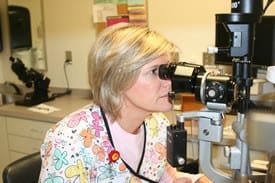UAMS Sees Ophthalmic Med Techs Stature Raised
| May 8, 2009 | For a profession listed as one of the fastest growing in the nation, Suzanne Hansen, chairman of the UAMS ophthalmic medical technology program says it sometimes struggles to recruit students. “Many people still are not aware of the profession,” said Hansen, who leads the program in the UAMS College of Health Related Professions. It’s one of only five in the United States accredited by the Commission on Accreditation of Ophthalmic Medical Programs. A recent change in how the job is classified by the federal government could raise the stature of ophthalmic medical technology. The U.S. Bureau of Labor Statistics’ Standard Occupational Classification Committee announced that beginning in 2010, ophthalmic medical technicians or technologists would be recognized as a separate occupational classification. Previously ophthalmic medical technologists (OMTs) were listed as an “Other Healthcare Support Occupation” alongside medical assistants. Now the profession is grouped under the category Health Technologists and Technicians with its own specific definition. The end result, said Hansen, is to raise awareness of the profession, the level of skills required and identifies a career path based on knowledge and skills. That could make the field more attractive to prospective students, she said. “The new classification shows how much this profession has evolved into a very technical field and more adequately reflects our job duties,” Hansen said. Ophthalmic medical technologists are allied health professionals who improve patient care by assisting the patient and physician. Technologists take patient histories, conduct various vision tests and assist in ophthalmic surgery. Hansen said the job outlook for OMTs is good. The Joint Commission on Allied Health Personnel in Ophthalmology cites data from the U.S. Department of Labor that indicate employment of medical assistants and technicians in fields such as ophthalmology ranks third on the list of the 30 Fastest-Growing Occupations in the U.S. The average starting salary for an OMT ranges from $31,000-$40,000 a year in Arkansas. For more than a decade, a shortage of qualified ophthalmic medical personnel has existed in communities nationwide. Today, it is estimated there is a need for an additional 6,000 ophthalmic medical personnel in this country. With a shortage of ophthalmologists, OMTs become more important, Hansen said, as physician extenders. By conducting many of the routine diagnostic tests and gathering patient information, they allow the physician to see more patients. That is important, as an aging population is expected to need more eye care just as they need other types of medical care. The UAMS OMT program accepts four or five students each year with two years of college prerequisites and provides two years of professional course work, for a total of four years of study. Graduates earn the Bachelor of Science degree. The program started in 2000, and six classes totaling 23 students have graduated. Applications are currently being accepted for the fall 2009 semester.
|
